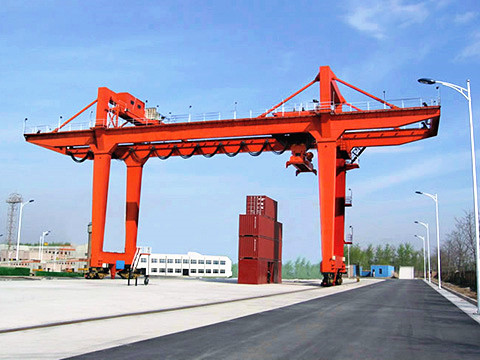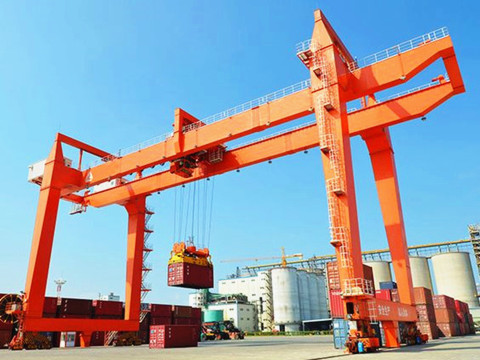Rail gantry cranes play a critical role in railway stations, particularly in handling large, heavy cargo such as containers, heavy equipment, and other substantial loads. Their efficiency and precision make them indispensable for streamlining operations in railway cargo yards. In this guide, we will explore how to properly use a rail gantry crane in a railway station, focusing on its functions, operation procedures, and safety measures to ensure efficient cargo handling.

Overview of Rail Gantry Cranes in Railway Stations
A rail gantry crane is a type of overhead crane that runs on rails and spans across a wide area, typically over railway tracks. These cranes are essential in moving containers from trains to trucks or storage areas and vice versa. Their robust structure, combined with their ability to travel along rails, allows them to cover large spans of track, making them ideal for logistics at railway terminals.
Key features of rail gantry cranes in railway stations include:
Heavy lifting capacity: These cranes are designed to handle containers weighing several tons, making them perfect for moving goods in large quantities.
High efficiency: Rail gantry cranes can quickly and precisely move containers, reducing idle time and improving throughput at busy railway stations.
Dual lifting mechanisms: Many rail gantry cranes come with both a primary hoist for heavy loads and a secondary, smaller hoist for lighter tasks.
Primary Applications of Rail Gantry Cranes at Railway Stations
Rail gantry cranes in railway stations are mainly used for the following tasks:
Loading and unloading containers: The primary use of rail gantry cranes in railway stations is to move containers between trains, trucks, and storage areas. The crane’s ability to span over multiple rail tracks allows for efficient transfer of goods without significant delays.
Heavy-duty cargo handling: In addition to containers, rail gantry cranes can lift and transport other heavy loads such as machinery, vehicles, and large structural components.
Stacking and organizing containers: Some railway stations may use rail gantry cranes for stacking containers in organized rows or stacks, optimizing space and making future operations smoother.

How to Operate a Rail Gantry Crane in a Railway Station
Operating a rail gantry crane requires specialized training and an understanding of the machinery’s control systems. Below are the key steps and considerations for operating a rail gantry crane effectively:
a) Preparation and Inspection
Before operating a rail gantry crane, it’s critical to perform a thorough inspection to ensure all systems are functional. This includes:
Checking the crane’s tracks: Ensure that the rails are free from debris and any obstructions that could interfere with crane movement.
Inspecting the hoist: Verify that the lifting mechanisms are in good condition, with no signs of wear or damage on ropes, chains, or hooks.
Control system check: Test the crane’s control system to ensure it’s responsive and that all emergency stop functions are working.
Weather considerations: Rail gantry crane operations can be affected by adverse weather conditions. High winds or heavy rain can impact crane stability, so it’s essential to monitor weather forecasts and avoid operation in unsafe conditions.
b) Operating Procedures
Once the crane is inspected and ready for operation, follow these steps for safe and efficient use:
Position the crane over the desired track: Using the crane’s rail system, move the crane along its track to the appropriate position over the railway line where the cargo needs to be handled.
Align the hoist with the cargo: The crane operator should precisely align the hoist above the load (e.g., a container), ensuring the hook or spreader bar is securely attached.
Lift the load carefully: Once the cargo is securely attached, the crane should lift it slowly and steadily. Rapid lifting can cause the load to swing, increasing the risk of accidents.
Transport the load: After the cargo is lifted, move the crane along the rails to transport the load to its destination, whether that’s onto a truck, into a storage area, or onto another train.
Lowering the load: Once in position, lower the load carefully, ensuring it is placed on a stable surface. The operator should ensure no personnel are underneath the load at any time.
c) Safety Measures and Precautions
Safety is paramount when operating heavy machinery (https://aicranemachine.com/gantry-crane/heavy-duty/) like a rail gantry crane. The following precautions should be taken:
Personnel clearance: Ensure that all personnel are at a safe distance from the crane and the load during operations. No one should be under the crane’s path or near the load when it’s being lifted or lowered.
Communication systems: Use clear communication between crane operators, signalers, and ground workers. In busy environments like railway stations, miscommunication can lead to accidents.
Emergency protocols: Operators must be trained in emergency protocols, such as how to safely stop the crane in the event of an emergency and how to handle system malfunctions.
Regular maintenance: Ensure that the crane undergoes routine maintenance to prevent wear and tear that could lead to operational failures.
Maximizing Efficiency with Rail Gantry Cranes
Efficiency is crucial for optimizing the use of a rail gantry crane in a railway station. Here are some strategies to maximize efficiency:
Automated systems: Some modern rail gantry cranes come equipped with automation and smart controls. These systems can help reduce human error, optimize load handling speed, and increase operational accuracy.
Strategic planning: Pre-plan the loading and unloading process to minimize crane idle time. This includes coordinating train schedules, truck arrivals, and available storage space.
Regular training: Continuous training of crane operators ensures that they are up-to-date with the latest operational techniques and safety protocols, improving overall efficiency and safety.
Common Challenges in Using Rail Gantry Cranes
While rail gantry cranes are essential for railway station logistics, there are some challenges associated with their use:
Weather dependencies: As mentioned earlier, adverse weather conditions can severely impact crane operations. Rain, snow, and strong winds can reduce visibility, hinder stability, and increase operational risks.
Track maintenance: Regular maintenance of the rail tracks is essential to avoid disruptions. Any misalignment or damage to the tracks can cause delays in operations.
Space limitations: In some railway stations, space may be limited, requiring careful planning to avoid congestion and maximize operational efficiency.
The rail gantry crane is a highly efficient tool for managing cargo at railway stations, especially for handling heavy loads like containers. Its ability to traverse over railway tracks and lift substantial weights makes it indispensable for improving logistics and reducing downtime. To use a rail gantry crane effectively, operators must ensure regular inspections, follow proper operational protocols, and maintain stringent safety standards. By maximizing the crane’s efficiency and addressing operational challenges, railway stations can significantly enhance their cargo handling capabilities, resulting in smoother and faster transportation processes.
